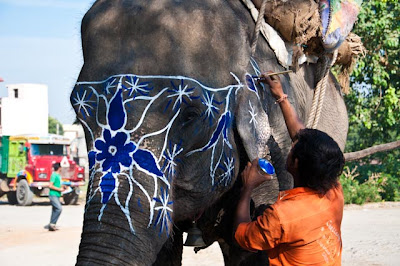After treading the soft sand, one can enter the clear water and feel the cold flowing Yamuna. Looking around, standing besides the vegetable farms amidst the pollution free air, one can soak in the absolutely relaxing sight, a boon for a stressed city slicker. At times, one can even catch a glimpse of fresh catch by fishermen returning in their traditional wooden boats.
No, this is not a description of a camp by a Himalayan river. It is very much a part of the megalopolis Delhi. Jagatpur in north Delhi gave an “unexpected” “can’t believe we are in Delhi” feeling to most of the Yamuna Katha members and other yatris.
 |
| Yamunabank in Jagatpur |
Exception was Chhote Khan, a 32-year-old farmer who lives on the Yamuna floodplains almost six months a year. His large joint family stays near Shashtri Park on the eastern bank of Yamuna. “We call her Jamunaji.”
Every member of his family is associated with Jamunaji in some or the other capacity, most of them in agriculture practice. Just like that at Jagatpur, Chhote’s family too has 35 bighas of land on lease.
“We go there to stay on the very next day of Diwali. We live in temporary houses. We stay there till minimum June 15, a designated date after which the authorities can release water upstream without warning,” he informs.
Akansha Dwivedi, 23 and Arun Raj, 23, both volunteers of the NGO Force, are working on a campaign called ‘blue city campaign’. They had joined the Yamuna Katha yatris for a day for the Jagatpur visit. Even after several minutes of reaching Jagatpur, it was a bit hard for Arun to actually believe that he was in Delhi. “After knowing filthy areas such as Nigambodh ghat and Okhla barrage, this is simply wonderful. This place was unknown to me earlier.”
 |
| Akansha Dwivedi and Arun Raj, volunteers of the NGO Force in conversation with Germans |
Then there was female elephant Rupa joining the team at the riverfront. Rupa’s mahaut Akram Khan has been tending the animal for last 2-3 years. Before too Akram was into keeping elephants. “Elephants can recognize humans with smell. Just by smelling, an elephant can know if the mahaut has handled any elephants.”
 |
| Elephant Rupa getting make up |
Rupa’s owner is Zahid Ahmed. Handling elephants is akin to handling humans. They have emotions. Few are good and few are stubborn, just like brats. But all said and done, it is Rupa’s “simplicity” what Zahid likes the most.
The almost virgin riverfront offered several other “new” things for the majority of Yamuna Katha group as coming from urbane conditioning, fishing, livestock and farming were novelty for them. The riverbank also offered a series of photo opportunities for the shutterbugs.
First came a bunch of fishermen carrying a newly painted wooden boat to be tried in water. While they were readying the boat, came along another boat with 5-6 fishermen readying for embarking on a fishing expedition upstream of the Yamuna. Bhola Kashyap, resident of the Okhla ghat who has fishing trade license, immediately took charge.
One by one, Bhola showed the catch, told names and USP. He also regaled the members with fishing expedition anecdotes. But nobody was quite prepared to witness a herd of buffaloes, blowing dust on their way towards water, gently sliding into the water and swiftly swimming to the riverine island. The buffaloes from Jagatpur village swim to the islands every morning and come back the same way every evening.
 |
| Local fishermen catching fish in Yamuna |
After much frolicking and fun time, several team members went for a walk along the Yamuna. On one side was the water, waves gently lapping the sandy bank, and on the other side was large swathe of agriculture farms with a variety of vegetables grown.
Chhote continued to inform: Tori, Ghiya, Karela, Kheera, Tomatoes, Kharbuja and Tarbuja are the commonly grown things on the Yamuna floodplains. “Vegetable farming is a gamble. There is no guarantee that the return on investment would be complete,” the barely literate Chhote – who claimed to be a brat in school days and hence did not study much – said in what was a practical wisdom backed statement. True, as unseasonal rains frequently wash away the agriculture crop.
Generally farmers tilling the Yamuna floodplains go in for three sowings. Then, whichever is ready first, will be take out.
“Whatever it may be, but always the first offering will be given to Polbagh dargah. Nobody knows exactly where but it is believed it is inside the Yamuna somewhere. It is also called Khwaja Khadar, a dargah deep inside the Yamuna,” he said. All Muslim families will offer chawal ki kheer (rice pudding) to this dargah.
Chhote kept on comparing farming at Jagatpur with that near his place while Bhola rued the absence of such practices near Okhla, simply because the riverfront is encroached and the water too toxic.
However, unlike earlier times, when they planted tarbuja and kharbuja, it is stopped now for almost two decades. “These plants tend to soak in high toxins.” The farmers dug bore wells into the river bed for drinking and agriculture needs.
After the walk, everybody proceeded for the next halt Ramghat, just north of Wazirabad. Team members mingled with each other over the delicious lunch.
 |
| Ramghat |
The ghat (stepped embankment) was another out-of-Delhi experience for the Yamuna Katha team, which had several German nationals too. The waterfront was so similar to a rural ghat. “Why didn’t we know these wonderful places earlier?” was a question on everybody’s lips as they departed for the next stop.
No comments:
Post a Comment